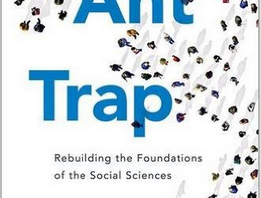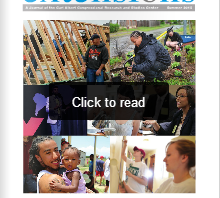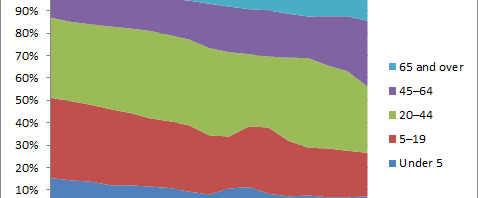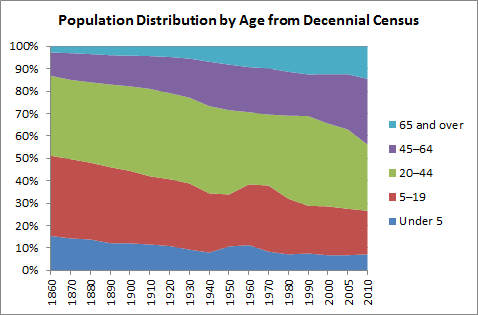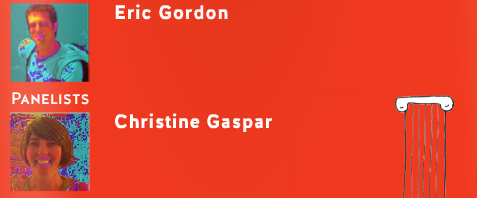- Facebook686
- Total 686
Consider these statements: “A group just is the people who make it up.” “If a group can be said to have intentions at all, its intentions must somehow be the intentions of its members.” Or: “When a convention arises, such as the convention that a dollar has value, it must exist because the people who use dollars have imposed some meaning on material reality.”
In The Ant Trap: Rebuilding the Foundations of the Social Sciences, Brian Epstein criticizes an assumption that is implicit in these statements (which are mine, not his): that social phenomena can be fully explained by talking about people. It’s obvious that non-human phenomena–from evolution to climate change–influence or shape human beings. But the thesis that people fully determine social phenomena is worth critical scrutiny.
Epstein’s book is methodical and not subject to a short paraphrase, but some examples may give a flavor of the argument. For instance, is Starbucks composed of the people who work for it? Clearly not, because the coffee beans and water, the physical buildings, the company’s stock value, the customers and vendors, the rival coffee shops in the same markets, and many other factors make it the company that we know, just as much as its own people do. Indeed, its personnel could all turn over through an orderly process and it would still be Starbucks.
Likewise, if the Supreme Court intended to overturn the ban on corporate campaign contributions, was its intention a function of the preferences of the nine individual justices? No, because in order for them to intend to overturn the ban, they had to be legitimate Supreme Court justices within a legal system that presented them with this decision at a given moment. I could form an opinion of the Citizens United case, but I could not “intend” to rule for the government in that case, because I am not a justice. And what makes someone a justice at the moment when the Citizens United case comes before the court is a whole series of decisions by people not on the court, going back to founding era.
In general, Epstein writes, “facts about a group are not determined just by facts about its members.” And it’s not just other people who get involved. Non-human phenomena can be implicated in complicated ways. For instance, the Supreme Court is in session on certain days, and on all other days, a “vote” by a justice would not really be a vote. What makes us say that a certain day has arrived is the movement of the earth around the sun. So the motion of a heavenly body is implicated in the existence and the intentions of the Supreme Court. That is an apt example, because Epstein calls for a Copernican Revolution in which we stop seeing the social world as “anthropocentric.”
Note that we are talking here about grounding relations, not causation. Public opinion may influence the composition of the Supreme Court and its decisions. The movement of the earth does not influence or affect the Court, and you wouldn’t model it that way (with the earth as an independent variable). Rather, the court is in session on certain dates, and the calendar is grounded in facts about the solar system. Likewise, a president can influence the court, and you could model the president’s ideology as an independent variable. But the composition of the court is grounded in decisions by presidents and senates in a more fundamental way than causation. To be a justice is (in part) to have been nominated and confirmed.
When people criticize anthropocentrism, usually they mean to take human beings down a peg. But in this case, the critique is a testament to our creativity and agency. Human beings can create groups in limitless ways. We can intentionally ground facts about groups in circumstances beyond the control of their members, or indeed in facts that are under no human’s control (like the motion of the earth). It can be wise to limit the power of group members in just these ways. Epstein writes, “Our ability to anchor social facts to have nearly arbitrary grounds is the very thing that makes the social world so flexible and powerful. Why would we deprive ourselves of that flexibility?” But the same flexibility that empowers the human beings who design and operate groups also creates headaches for the analysts who try to model their work. “Compared to the social sciences, the ontology of natural science is a walk in the park.”
The Ant Trap does not offer one model as an alternative to the standard anthropocentric ones, because social phenomena are diverse as well as complex. But if we narrow the focus a bit from the whole social world and look at groups, they tend to require (in Epstein’s analysis), a two-level model. Various facts about each group are grounded in other facts. For instance, the fact that the Supreme Court is in session is grounded in facts about the calendar (as well as many other kinds of facts). In turn, these grounding relationships are anchored in different facts–for instance, facts about how US Constitution organized the judiciary system.
My day job involves very conventional social science. We study various groups, from Millennials and voters to Members of Congress. After reading The Ant Trap, I won’t think of groups in the same way again. I am not yet sure what specific methodological implications follow, but that seems an important question to pursue.
See also Brian Epstein’s TedX Standford talk, which captures some of the book.
